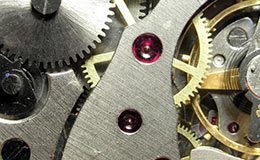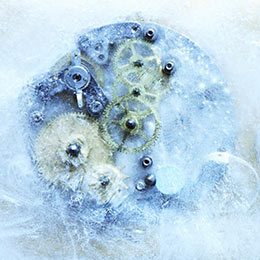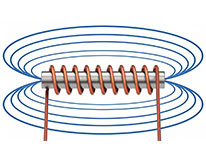Mechanical Movements

Mechanical watch movements - whether an automatic wind or a manual wind - are comprised of small gears, miniature screws and paper-thin springs. To combine all these miniscule pieces, and create a working, accurate watch is an amazing feat to begin with.
Mechanical wristwatches, especially modern ones with jeweled movements, can last forever with the right care. They can, as well, be brought back to life if in reasonable condition.
Accuracy of Mechanical Wristwatches - What to Expect
In the world of mechanics, anything assembled of small parts which are capable of maintaining 99% accuracy would be considered a top-tiered piece of machinery. To put things in perspective, if a watch is only 99.9% accurate it would be off by 1 minute and 27 seconds per day, which is unacceptable in the luxury watch world.
Accuracy is dependant on a few variables, such as:
- Position: Due to gravity a watch will gain or loose more time if laid to rest in a single position. The balance wheel has been adjusted to compensate for losses and gains in different positions. An adjusted watch should perform overall within the specification when worn throughout the day. If you remove the watch at night you may want to find the optimum position that will compensate for drift during wear.
Watches are typically adjusted to between 2 - 8 positions:
- Dial Up
- Crown Down
- Dial Down
- Crown Left
- Crown Up
- Crown Right
- Half-way position crown up
- Half-way position crown down
A watch adjust to 2 positions has been adjusted to the first 2 positions, a watch that has been adjusted to 4 positions has generally been adjusted to the above 4 positions and so on.
- Temperature:
 The environment may have an impact on how accurate the watch operates. Temperature changes expand and contract many of the parts, changing the dimension and shapes - especially the balance wheel and hairspring. In modern watches most materials and designs are able to compensate for the changes and maintain a consistent rate. This is generally not a problem unless the watch is constantly in extreme weather environments and is corrected by a very simple regulation.
The environment may have an impact on how accurate the watch operates. Temperature changes expand and contract many of the parts, changing the dimension and shapes - especially the balance wheel and hairspring. In modern watches most materials and designs are able to compensate for the changes and maintain a consistent rate. This is generally not a problem unless the watch is constantly in extreme weather environments and is corrected by a very simple regulation.
The standard acceptable accuracy of mechanical wristwatches is as follows:
| Modern Mechanical non-COSC Certified watch |
|---|
| Worst Case Scenario |
+/-10 seconds per day |
99.988% accuracy |
| Typical |
+/-5 seconds per day |
99.994% accuracy |
| Excellent |
+/-3 seconds per day |
99.996% accuracy |
| Modern Mechanical COSC Certified watch |
|---|
| Worst Case Scenario |
+6/-4 seconds per day |
99.994% accuracy |
| Typical |
+/-3 seconds per day |
99.996% accuracy |
| Excellent |
+/-1 seconds per day |
99.998% accuracy |
It is important to understand that a fresh watch off the shelf may need a break-in period of a month or so. This allows the watch to find its beat and distribute the lubricants evenly. If you find the watch not to be as accurate as you would expect after the break-in period, there are generally two courses of action to increase accuracy - both being minor in nature, but require competent watchmakers to perform:
- Regulation: This is for a watch that runs consistently too fast or too slow - the keyword being "consistent". The solution would be to regulate the beat rate accordingly. This is a very simple and relatively quick procedure achieved by turning a screw. With the appropriate time-measuring machinery a qualified watchmaker can accomplish this in a matter of minutes. This procedure is probably one of the most common tasks for a watchmaker.
- Adjustment: This is for a watch that is fast or slow or does not have a consistent rate, especially in different positions. The balance wheel needs to be adjusted to compensate for the different positions. Although this too is a simple procedure, it does require a little more time to correct as each position needs to be monitored and adjusted.
Maintenance and Frequency of Service

A mechanical wristwatch is comprised of small gears, miniature screws and paper-thin springs - as with any mechanical instruments that have constantly moving parts, a mechanical watch requires periodic maintenance.
As a watch ages the lubricants start to break down and the gears shift ever so slightly, and the accuracy of the watch will decline as well. The accuracy may be compensated by performing a couple of regulations (see above) over the course of a few years. However, ultimately a complete overhaul will be required. There are a few methods of thought to the frequency of service. Some say that a service should be done every 2-3 years as the manufacturer suggests. Others subscribe to the "if it ain't broke, don't fix it" rule and will only send it in to the manufacturer once the watch stops working - which could be many years. We suggest a middle ground, the watch should be sent in every 5 years - or sooner if you notice something amiss. Waiting longer than 5 years to send it in will result in undue stress wearing out different parts, ultimately costing more to replace those components. A complete overhaul entails disassembling the movement, inspecting each component, replacing any damaged components, cleaning each part, lubricating, reassembling, adjusting and regulating the movement.
The cost for a complete overhaul could start at roughly $250 for a simple watch, going up to $500 for a chronograph and into the thousands for a highly complicated watch.
A typical maintenance requires the watch to be opened, the movement dismantled, and each component cleaned and lubricated. The movement is then reassembled, regulated, the gaskets changed, and finally, tested.
Learn more about water resistance.
A Few Notes About Accuracy
Magnetism: If a watch suddenly begins running extremely fast (20+ seconds per day to hours fast per day) it is usually an indication that the hairspring coils are magnetized, causing the coils to stick together. This shortens the rotation of the balance wheel and increases the beat rate extremely. Correcting this is one of the simplest tasks for a watch maker. The watch need not be opened (only in extreme cases) it is passed through a demagnetizing machine and is ready to go again. Magnetism can also cause a watch to stop or run slow; however, generally the watch will run fast.
If a watch suddenly begins running extremely fast (20+ seconds per day to hours fast per day) it is usually an indication that the hairspring coils are magnetized, causing the coils to stick together. This shortens the rotation of the balance wheel and increases the beat rate extremely. Correcting this is one of the simplest tasks for a watch maker. The watch need not be opened (only in extreme cases) it is passed through a demagnetizing machine and is ready to go again. Magnetism can also cause a watch to stop or run slow; however, generally the watch will run fast.
Tangled Coils:
This could be caused by a small jolt to the movement. Although this is less likely than magnetism it is still a common cause of a watch running extremely fast. The coils are entangled, and this shortens the rotation of the balance wheel and significantly increases the beat rate. The good news is that the fix is fairly simple for a qualified watchmaker to accomplish.
Overall Poor Operation:
This is rare on a new watch and will generally be the case of a watch that is 4-5 years old. If the watch runs slow and cannot be corrected by a regulation, does not maintain a power reserve, stops working while on your wrist - it may signify a deeper issue, where the skills of an expert watchmaker are required to pin-point and correct the problem. The most extreme resolution is to have the watch completely overhauled. We generally recommend sending the watch back to the respective company for a job as such.
Quartz/Battery-Operated Watches
What is a Quartz watch?

Quartz timepieces use the quartz crystals to provide a very accurate resonator which gives a constant electronic signal for timekeeping purposes. Quartz crystals are piezoelectric, which means that they generate an electrical charge when mechanical pressure is applied to them. They also vibrate if an electrical charge is applied to them. The frequency of this vibration is a function of the cut and shape of the crystal. Quartz crystals can be cut at a consistent size and shape to vibrate at thousands of times per second, making them extremely stable resonators for keeping very accurate time.
Accuracy:
Modern quartz/battery operated watches are generally more consistently accurate than mechanical wristwatches. Quartz watches are typically accurate to +/-1 second per day. Unlike mechanical wristwatches, where accuracy is dependant upon a variety of factors such as gravity, tolerances and lubricants, quartz watches will keep a consistent time to whatever the original accuracy is. However certain environments may cause quartz watches to lose their accuracy such as proximity to high magnetic fields such as MRI equipment, doctors' offices with x-ray equipment, dentist offices, etc.
As most quartz watches easily outperform the COSC requirement for mechanical wristwatches, the COSC created a whole separate set of tests and standards for a quartz movement requiring the watch to stay accurate to an amazing 0.02 seconds per day!
As the cost of the COSC test is high, most companies choose not to certify their watches, as this would increase the price of the watch drastically. However, there are a few exceptions such as Breitling quartz watches.
Following is what you can expect in terms of accuracy from quartz watches:
| Modern Quartz (battery) Operated non-COSC Certified watch |
|---|
| Worst Case Scenario |
+/-2 seconds per day |
99.997% accuracy |
| Typical |
+/-1 seconds per day |
99.998% accuracy |
| Excellent |
+/-0.5 seconds per day |
99.999% accuracy |
| Modern Quartz (battery) Operated COSC Certified watch |
|---|
| Worst Case Scenario |
+/-0.02 seconds per day |
99.99998% accuracy |
| Typical |
+/-0.02 seconds per day |
99.99998% |
| Excellent |
+/-0.00 seconds per day |
100% accuracy |
Other pros of quartz watches:
- Servicing is less expensive than a mechanical wristwatch. As there are only a few gears for the drive train (hand, minutes and seconds) most quartz watches require a less frequent and less entailed servicing. General servicing will consist of a cleaning, lubricating the few gears, replacing the battery, changing the gaskets and water resistance testing.
- There is no need to make sure the watch is wound, which means less attention need be focused on the watch.
Our recommendations:
- Have your watch water tested once a year. Learn more about water resistance.
- Send the watch to the respective manufacturer every other battery change for a complete service.
- When having the battery changed, make sure you find a watchmaker that has the capability to open, seal and test the watch. Generally, you can find such watchmakers affiliated with or at a local authorized dealer for fine brand name watches (not necessarily your brand, but a brand of equivalent status).


 The environment may have an impact on how accurate the watch operates. Temperature changes expand and contract many of the parts, changing the dimension and shapes - especially the balance wheel and hairspring. In modern watches most materials and designs are able to compensate for the changes and maintain a consistent rate. This is generally not a problem unless the watch is constantly in extreme weather environments and is corrected by a very simple regulation.
The environment may have an impact on how accurate the watch operates. Temperature changes expand and contract many of the parts, changing the dimension and shapes - especially the balance wheel and hairspring. In modern watches most materials and designs are able to compensate for the changes and maintain a consistent rate. This is generally not a problem unless the watch is constantly in extreme weather environments and is corrected by a very simple regulation.
 If a watch suddenly begins running extremely fast (20+ seconds per day to hours fast per day) it is usually an indication that the hairspring coils are magnetized, causing the coils to stick together. This shortens the rotation of the balance wheel and increases the beat rate extremely. Correcting this is one of the simplest tasks for a watch maker. The watch need not be opened (only in extreme cases) it is passed through a demagnetizing machine and is ready to go again. Magnetism can also cause a watch to stop or run slow; however, generally the watch will run fast.
If a watch suddenly begins running extremely fast (20+ seconds per day to hours fast per day) it is usually an indication that the hairspring coils are magnetized, causing the coils to stick together. This shortens the rotation of the balance wheel and increases the beat rate extremely. Correcting this is one of the simplest tasks for a watch maker. The watch need not be opened (only in extreme cases) it is passed through a demagnetizing machine and is ready to go again. Magnetism can also cause a watch to stop or run slow; however, generally the watch will run fast. 